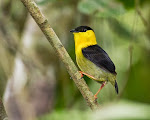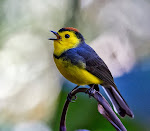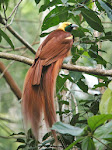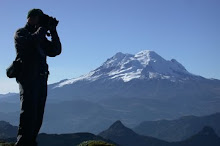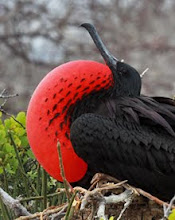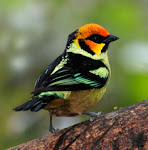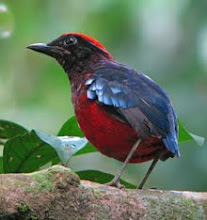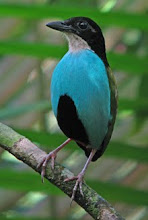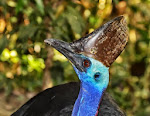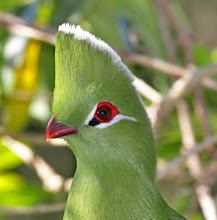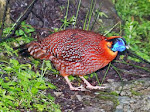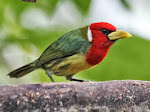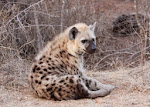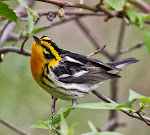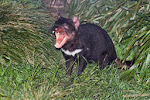One
of the great advantages of birding in a country as small as Ecuador
(similar in size to US state of Colorado, smaller than Italy), which also has a
decent road network, is that you can move from one sort of birding area to
another rather swiftly. That is exactly what we did on this day, beginning our
day with some dawn time birding at 300m/980ft in a hilly part of the humid
Amazon jungle, but ending the day in the high Andes, in the positively cold
Antisana area (in view of some distant snow cones), at nearly 11,600ft/3550m.
Waking up at Gareno Lodge,
having already visited their centrepiece attraction, the currently nesting
Harpy Eagles, we did some local birding around their garden to start with. Once
again, this yielded Fiery Topaz, a
single male hovering overhead repeatedly, but typically refusing to land
somewhere he could be photographed; (i.e. always in the near pitch-black forest
understory. Grey-breasted Sabrewing
was also visiting some flowers in the garden. With little else happening, we set off for an area near Tena, in the hope of a Sungrebe, on a lagoon there. En-route, a pair of Laughing Falcons were clearly worth stopping for...
While the day had opened without rain, this changed as we arrived on site, when the skies emptied above us. We sheltered for a while, waited for the rain to ease and then set off by boat for the Sungrebe. Unfortunately, during this rainy boat ride, we did not find that Amazonian wraith, but did see a feisty Poeppig’s Woolly Monkey, which seemed to take particular objection to us...
Meanwhile, an acrobatic White-bellied Spider-Monkey,
doing gymnastics style movements overheads that US Olympic champion Simone Biles
would be proud of. Nearby, a Graells's (Napo) Tamarin hugged the trunk of a tree tight, before suddenly launching into the jungle, and evaporating into thin air!
While nothing out of the ordinary was seen, any boat ride in
the Amazon is exciting and magnetic, and we enjoyed some “Jurassic birds”, in
the form of the many hissing Hoatzins that
lumbered around the cecropias lining
the banks of the lagoon, and a White-necked Puffbird sitting typically high on an open branch, with all the horrific backlight that goes with that; (the constant foe of nature photographers). If you have not seen a Hoatzin, this species/monotypic family is well worth
observing, they simply feel like they are a species that existed while T Rex
wandered the Earth, and has refused to evolve ever since! I mean this as a
compliment by the way, I love Hoatzins, as they are unique, bizarre, and
emblematic of the Amazon, a place that every keen birder should adore, as I do.
An
excellent traditional meal was taken for lunch (Maito de tilapia), prepared by our guide Pedro. This took the form
of fish wrapped tightly within the leaves of a particular tree species, and
cooked over hot coals, making it incredibly flavoursome, and combined with yucca
and hot red chiles.
With
one of the party flying out of Quito that night, we had decisions to make; with
limited time remaining, do we retry for the sungrebes at this new site (stated
as normally reliable), or head straight for the high Andes and another target,
the largest hummingbird on Earth, the Scarlet Tanager-sized, Giant Hummingbird? The odds were quickly
weighed up, and with the hummingbird being nearly guaranteed, it was decided
that we should in the direction of the 5700m (18,715ft)-high Antisana
volcano, and a certain café that sits within its shadow. As we traveled there
from our position in Amazonian Tena, the time to get there ended up being a
little longer than expected, making it a little tense in terms of bagging a
last big bird for the tour participant. However, we arrived at Tambo Condor
restaurant in time, with 45 minutes of light still remaining in the day.
Immediately, the stark change in climate was palpable, and we were scrambling
for extra layers, in spite of a slim time limit left to find that Goliath among
hummers. Before, we had even started to look for that though, we admired
Ecuador’s national bird on the wing overhead – Andean Condor, another giant of
the bird world, with a wingspan that can reach 10ft/3m, or to put it another
way, considerably wider (nearly 3feet more than), the height of NBA player Shaquille
O’Neal, (think about that)! We admired its grace, and lack of need to take a single wingbeat, as it
cruised the entire length of the valley effortlessly.
We then moved to a small
set of hummingbird feeders at Tambo Condor,
where even in the frigid temperatures creeping into the late afternoon,
hummingbirds were bustling, chasing their final feeds of the day. The first we
were to see were a pair of Shining Sunbeams, both revealing their metallic coloured rumps that give rise to its extravagant name. Then, just around
the corner sat the object of our quest, a Giant Hummingbird sitting there like he owned the
joint, and dwarfing the sunbeams at their nearby feeder. While sunbeams may
take the trophy for looks, Giant
Hummingbird is impressive for its girth, it is one big hummingbird.
A great
end to a day that started with us watching Fiery
Topaz hovering in the humid air of the Amazon, and finished with Shining Sunbeams rushing around within
the icy air of the high Andes, where condors
still circled overhead…
It had been a very memorable 3 days of birding, which were
never meant to be for me, were it not for a delayed bag on American Airlines that
opened the way for me to travel to the Amazon with said bag, (and bins and camera!). The rest is now part of my own
personal avian history.






























